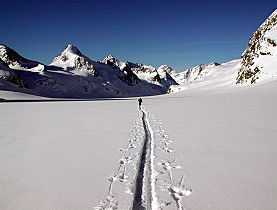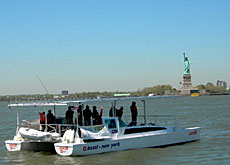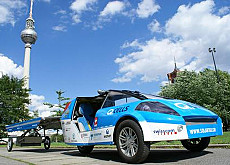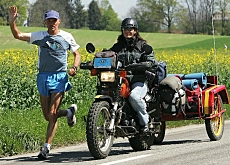Saving the planet the Swiss way

How far are you willing to go to stop global warming? A few Swiss are taking the problem so seriously they're walking, cycling and sailing to the ends of the earth.
At a time when activists have to go to great lengths to draw attention to their cause, embarking on a 12-year odyssey and raising a family along the way is still remarkable.
That’s what Dario and Sabine Schwoerer, along with their two toddlers, are doing.
They have been sailing, cycling and climbing for the past six years and are now in Australia but are only half way to achieving their goal of being the first to climb the highest peak on each continent in a non-stop, round-the-world journey.
But when they are not at sea or scrambling up a mountain face, the Schwoerers are visiting schools. Up until now, they have spoken to about 25,000 students.
Dario says their goal is to inspire children to protect the planet. They are leading by example – every single kilometre of the journey is being done either with wind power, by bicycle or on foot.
“It’s what makes sense to us, makes us happy and confident because we can influence young people. When we see that we can move people to make a change,” the climatologist and mountain guide told swissinfo, speaking with a missionary zeal.
But what is it that really drives people like the Schwoerers? If it weren’t climate change, would it be another worthy cause?
Inner voice
“It has to do with an inner voice, sometimes this inner voice says ‘do this’, and the inner voice has a lot to do with joy, feeling alive and taking risks,” explains Swiss doctor Martin Vosseler.
Vosseler, a specialist in psychosomatic medicine, has himself been known to go to extremes to raise awareness of climate change.
In the past few years, he’s sailed a solar-powered boat across the Atlantic and walked across much of Europe and the Middle East. He is now slow footing his way from west to east across the United States.
He says walking along roads with an emblem of the sun on his pack is an ideal way to tell the world that more can be done to reduce carbon emissions by harnessing solar energy. “I have contact with between 500 and 25,000 people a day,” the environmental activist told swissinfo by telephone from somewhere along highway 40.
Solar wave
“Every driver sees me. I wave to many of them and many wave back. They think ‘what kind of person would walk through the United States with a sun on his pack?’. And they eventually connect when they see a report in the newspaper or on television about me. So it’s a tremendous opportunity to spread the message.”
Both the Schwoerer family and Vosseler believe the message is urgent, and want to promote energy efficient technologies they have encountered along the way.
It is the development of thin, film solar cells manufactured in California for Vosseler and an ancient technique of preserving food without refrigeration that the Schwoerers were introduced to on the Pacific island state of Vanuatu.
“What we’ve recognised on this expedition is that if you want to survive, you have to respect nature and adapt to its rhythm. That’s what we are doing,” Dario says.
And the rhythm means accepting delays. The Schwoerers initially thought they could accomplish the seven seas, seven summits expedition in four years. When that proved impossible, they carried on, starting a family on the road instead of waiting to settle back in Switzerland.
Sails and umbilical cords
“As soon as you are a parent, the future – the coming generations – matters even more,” Dario says, recalling how he has not only used his Swiss army knife to fix a sail but also to cut the umbilical cords of his children when they were born.
The Schwoerers still have Everest, Kilimanjaro and Antarctica’s Mount Vinsent to climb before they’re finished.
And if they ever do complete the odyssey, they will have sailed 70,000 nautical miles, cycled 18,000 kilometres and climbed 400,000 metres in altitude. All to raise awareness of the dangers of climate change.
In contrast, Vosseler only has a couple thousand kilometres to go to reach Boston where he hopes to hitch a ride on a sailboat back to Europe. Maybe the Schwoerers will have made a detour by that time and will be going his way.
swissinfo, Dale Bechtel
Dario Schwoerer, a geographer and mountain guide, and his wife Sabine, a nurse as well as trained mountain guide, began the ToptoTop expedition in 2002 when they climbed the highest point in all of Switzerland’s 26 cantons.
Once that was completed, they began their round the world journey in a bid to reach the highest peak on each continent.
So far, they have succeeded in reaching the top of Europe’s Mount Blanc, South America’s Aconcagua, North America’s Denali, and Australia’s Kosciusko.
They intend to spend the rest of 2008 in Australia before heading to the Himalayas to continue their quest.
Vosseler set out from Los Angeles in January with the aim of walking to Boston – a journey of 5,500km – to raise awareness of climate change.
He wants to “demonstrate how each of us has a choice in how we use our personal energy and the energy resources of our planet”.
The long-time environmental activist has been a vocal opponent of nuclear energy and promoter of solar power. Vosseler took part in the pioneering Atlantic crossing by solar-powered boat, Sun21, last year.

In compliance with the JTI standards
More: SWI swissinfo.ch certified by the Journalism Trust Initiative




You can find an overview of ongoing debates with our journalists here. Please join us!
If you want to start a conversation about a topic raised in this article or want to report factual errors, email us at english@swissinfo.ch.